Infinite Mac: Turning To The Dark Side #
tl;dr: No, not Windows¹, but I’ve decided to expand Infinite Mac to the the black hardware that Mac users secretly lusted after in the 80s and 90s: NeXT. There is now a runnable collection of all notable NeXTStep versions, going from the initial 0.8 preview in 1988 to the final OPENSTEP 4.2 release in 1997.
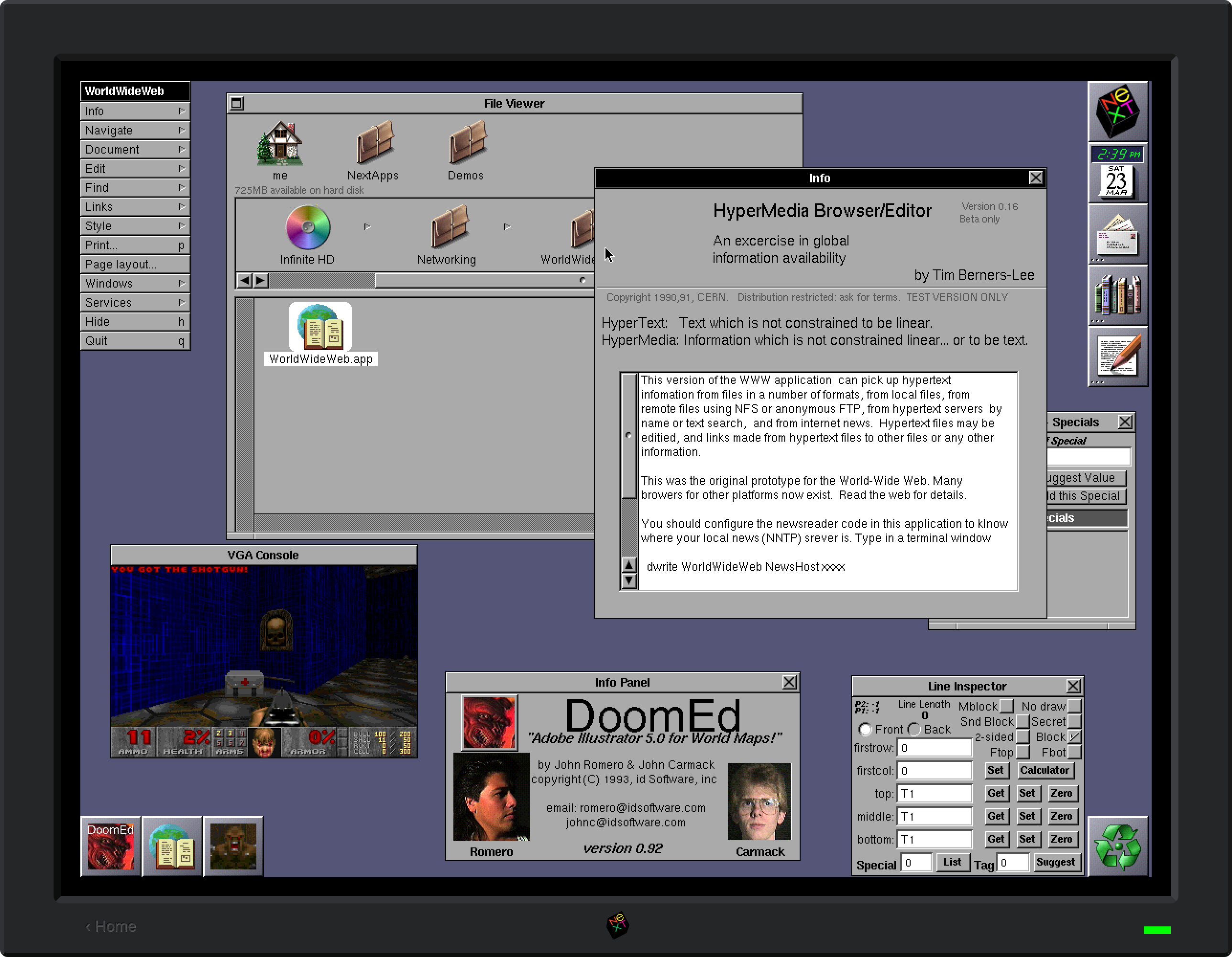
Porting Previous
About a year ago I came across the Previous emulator – it appeared to be a faithful simulation of the NeXT hardware and thus capable of running NeXTStep. While including it in Infinite Mac would be scope-creep, NeXT’s legacy is in many ways more relevant to today’s macOS than classic Mac OS. It also helped that it’s under active development by its original creator (see the epic thread in the NeXT Computers forums), and thus a modern, living codebase².
Previous is the fifth emulator that I’ve ported to WebAssembly/Emscripten and the Infinite Mac runtime, and it’s gotten easier. As I'm doing this work, I’m developing more and more empathy for those doing Mac game ports – some things are really easy and others become yak shaves due to the unintended consequences of choices made by the original developers. Previous is available on multiple platforms and has good abstractions, so overall it was a pretty pleasant experience.
The main challenge was the pervasive use of the SDL library – I don’t want any of it as a platform abstraction, since I have my own. I chose to replace the entry-point and several subsystems to avoid bringing in too much SDL code. Even with that, I still needed to have some stub files for dependencies that I couldn’t omit altogether. On the other hand, it was a pleasant surprise that adding sound support was trivial — the APIs that it needed mapped 1:1 with the ones I’d already exposed from the Infinite Mac runtime.
With the initial emulator being brought up, there were some more fun tasks, like adding a NeXT-style monitor frame and a NeXT appearance to the Infinite Mac controls (working on them is giving me Kaleidoscope scheme flashbacks).
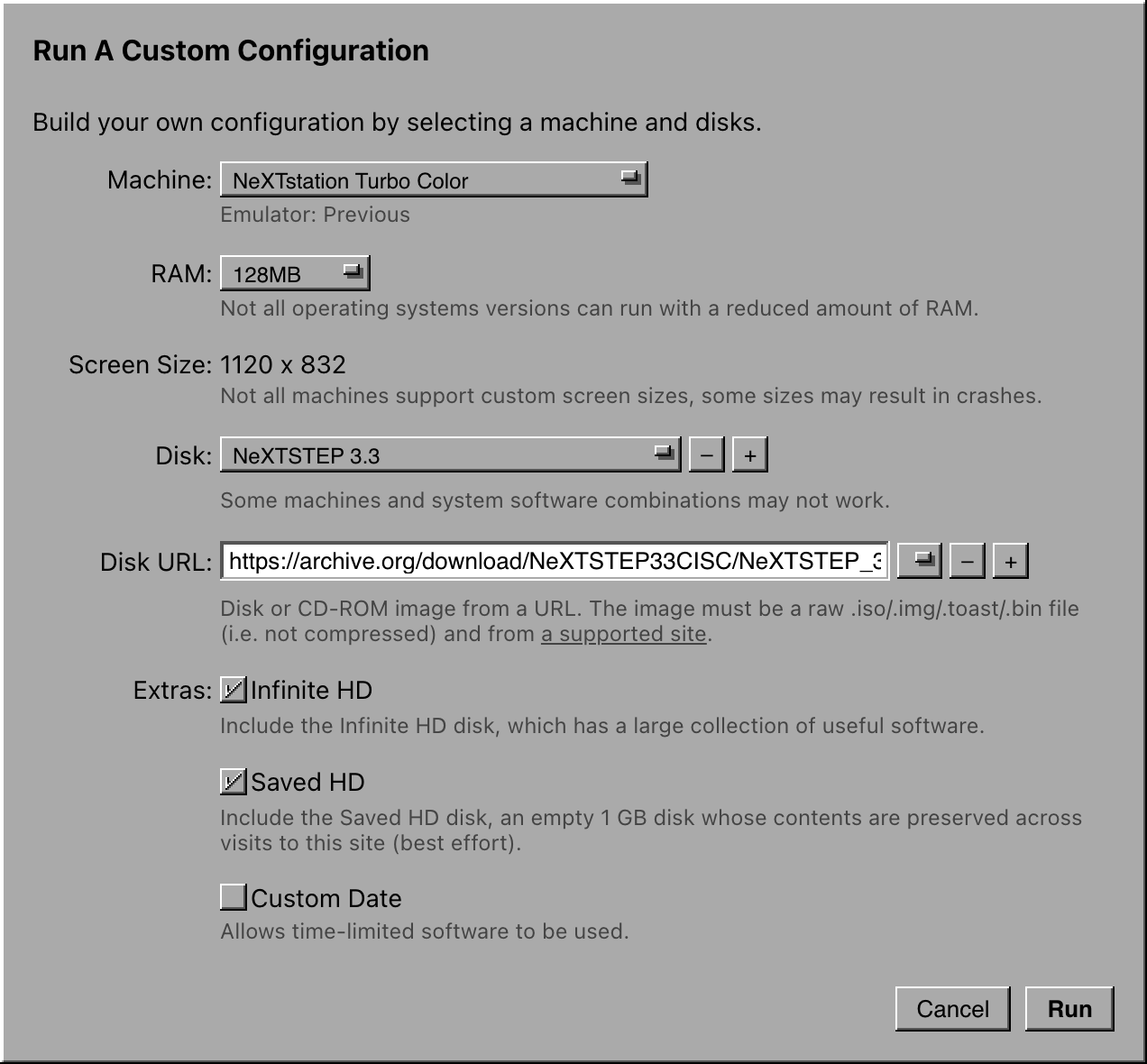
Once I had Previous running I did some profiling and was discovered the same excessive wasm-to-js/js-to-wasm ping-ponging that I noticed in DingusPPC – it also uses setjmp/longjmp to implement an exception handling mechanism for the MMU. The fix was also very similar: intentionally add an extra wrapping function that contains the CPU emulation loop.
The performance impact of the fix was not as noticeable because Previous tries to accurately simulate the performance characteristics of the original hardware (this is also why boot times are much longer). In fact, I had originally missed the speed checking that the native main loop does, and the emulator was running too fast, leading to timing-dependent things like double-clicking not working.
Speaking of mouse input, Previous uses relative mouse input — it accurately simulates real hardware so all it can do is behave as though a physical mouse is moving and generating updates. This was the case with DingusPPC too, and while the Pointer Lock API makes this work reasonably well on desktop browsers, it’s not a good fit for the mobile web. To make input more accessible on touch-enabled devices, I added a virtual trackpad mode that turns swipes and taps on the screen into mouse movements and clicks. This also helps with double-clicking and making pre-Mac OS 8.0 pull-down menus more usable, though it is somewhat finicky to trigger the drag-lock gesture (I now see why it’s so hard for other touchpad vendors to replicate all of Apple’s gestures).
As part of doing some of the integration work I became aware of just how much of a minority player NeXT was in the 80s and 90s computing world (even more so than Macs). For example, they had their text encoding/character set, and while Python (and other systems) have native support for the contemporary MacRoman encoding, I had to add my own to handle NeXT’s. Similarly, there is a convenient Python library for dealing with HFS disk images, but I could not find any for the UFS variant that NeXT used³.
The disk images with NeXTStep installs are quite large (hundreds of megabytes per version), and the Workers KV-based storage that I had been using was becoming increasingly ill-suited for them (and expensive). As part of this project I also switched to Cloudflare R2 (their S3-like object storage system). On one hand I’m not thrilled with the site becoming dependent on additional services, but on the other I do want to keep costs down. Luckily the dependency is not invasive — it would be trivial to store the disk chunks anywhere else (or to keep storing them as static files, the way I do in the local dev server).
Exploring NeXTStep
Although I was familiar with NeXTStep at a theoretical level and had spent a few hours using a slab in the mid 1990s, this was my first time using it in-depth. My first observation was that having it side-by-side with the contemporary Mac system software makes it even more apparent how much of an advance it was.

System 6.0 and NeXTStep 0.8: two very different releases from 1988

|

|
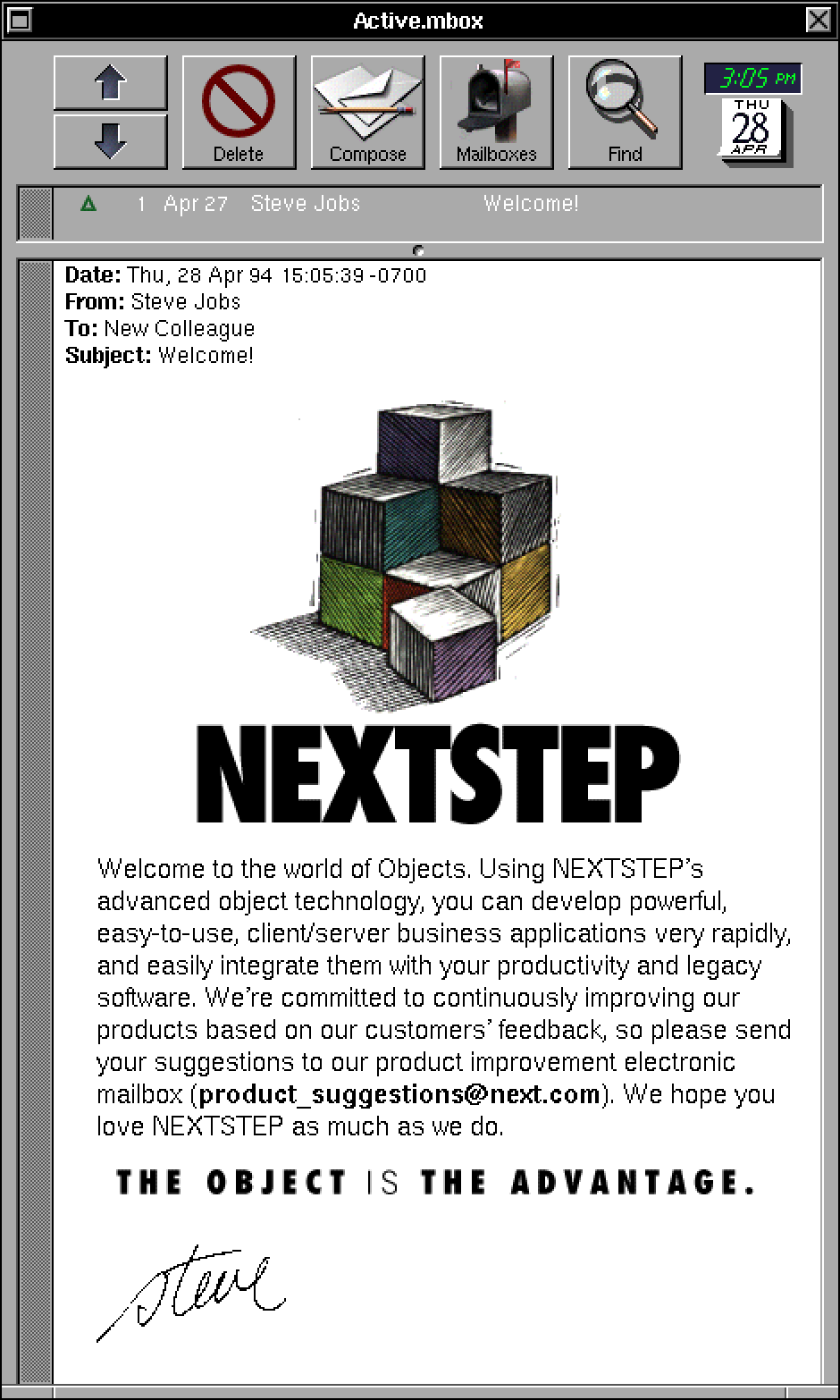
|
| Strategy du jour: productivity (NeXTStep 2.0), multimedia and internationalization (NeXTStep 3.0), object-oriented development (NeXTSTEP 3.3) | ||
I was also amused to notice a parallel with the early Mac system releases: the initial release is hard to find in pristine form (a copy of System 0.97 was only tracked down late last year). In both cases it’s it because of the very small number of copies produced, and because they shipped on read/write media (floppy disks for the Mac, magneto-optical disks in NeXT’s case), and thus ended up being used for personal storage too. For NeXTStep 0.8 the archive of images that forum member mikeboss created was the best source that I could find, though I’m happy to switch things over if a better one turns up.
As part of installing all of the OS versions I discovered that starting with NeXTStep 3.0 there is support for the HFS file system used by contemporary Macs. This means the Saved HD drive that has persistent storage also ends up working here. It can even be used as a virtual sneakernet to move data between NeXT and Mac installations on Infinite Mac (which means that it’s possible to get data in and out of the machines via Macs which have “The Outside World“ drive).
To make the systems more than a quick curiosity, I also created a NeXT version of the “Infinite HD” drive with pre-installed software. I had read stories about Doom and WorldWideWeb being developed on NeXTStep, and it was nice to make them accessible. I also added a NeXT version of the CD-ROM library feature, with one-click access to disks that have been preserved at the Internet Archive.
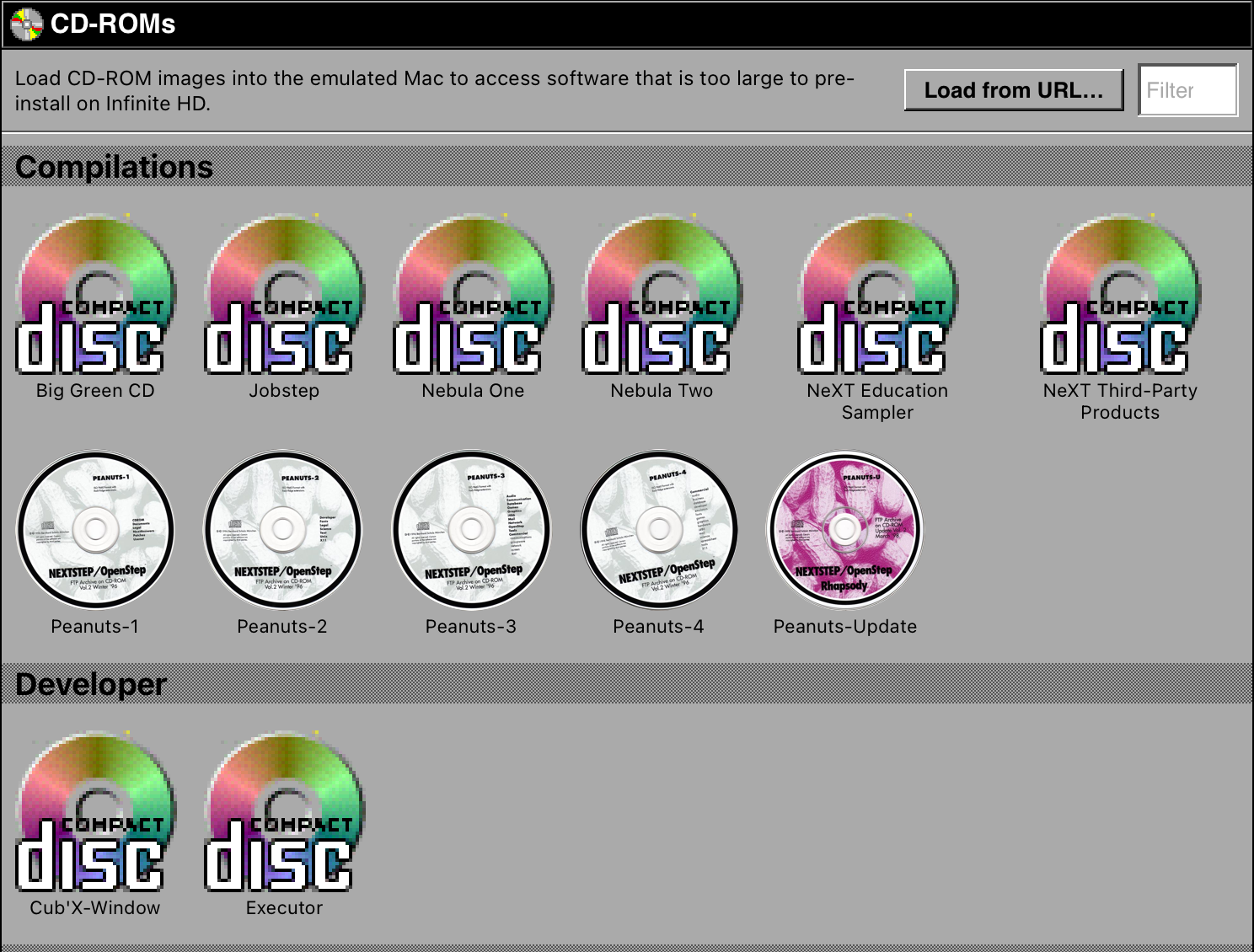
As part of finding more NeXT software to try out, I came across Daydream, which allows Mac software to run on black hardware. It’s technically not an emulator, instead it takes advantage of the fact that NeXT and Macs both used the Motorola 68K CPUs. It effectively turns your NeXT machine into a Mac that you dual-boot via the help of an adapter kernel. The original version needed a hardware dongle with genuine Mac ROMs, but a few years ago the NeXT Computers forum resurrected it such that it can run entirely via software. It’s this variant (known as Darkmatter) that is included on Infinite HD. In some ways this justifies the whole Previous side-quest — it’s just a more convoluted way to run the same classic Mac software as the rest of the Infinite Mac emulators.
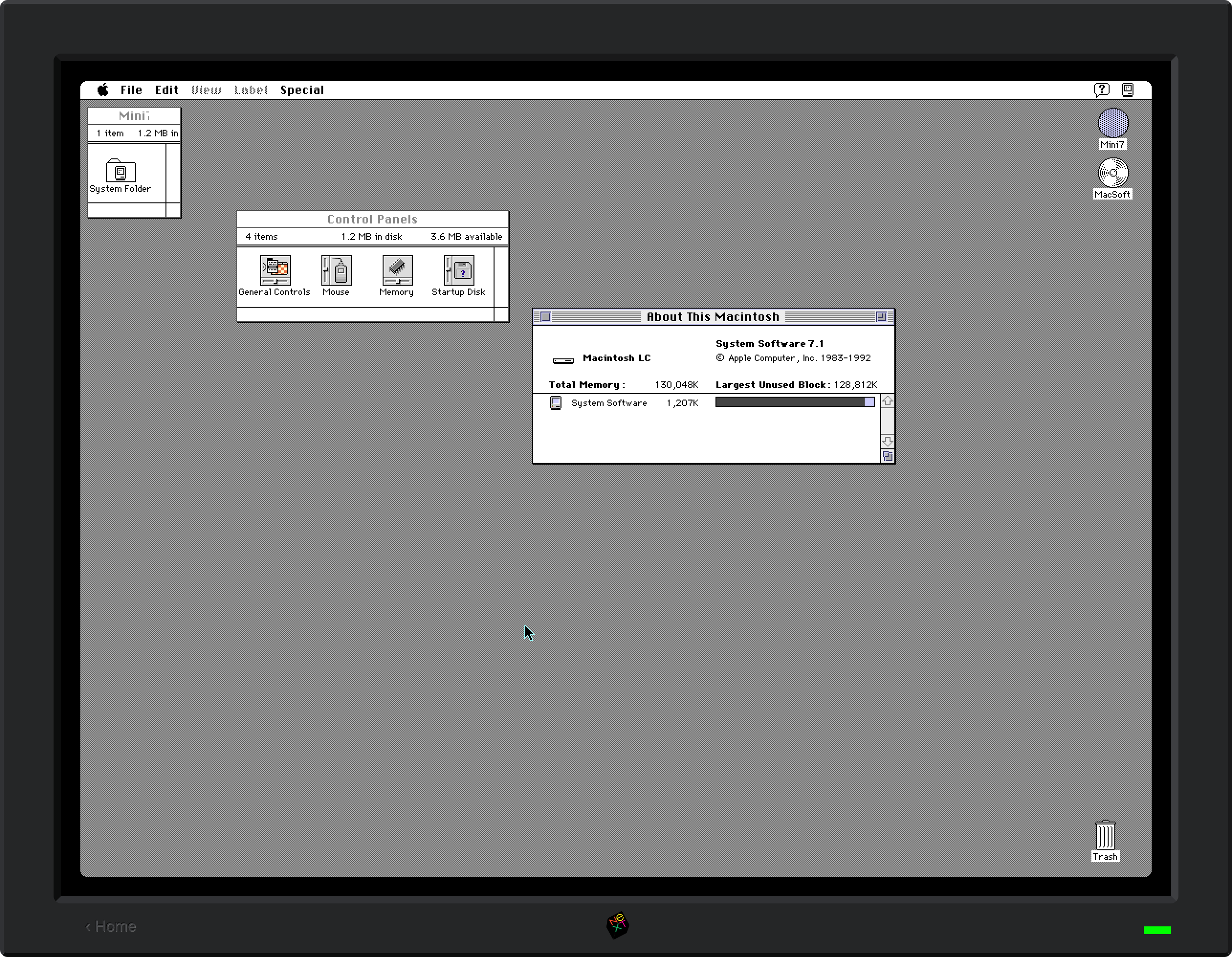
Things happen
Christopher Nolan (sort of) knows about Infinite Mac. I did a minor site redesign. After recalling the KanjiTalk New Year’s Day easter egg, I added custom date/time support so can you see it anytime you want. Infinite Mac is being used as a tool to make Playdate game art and other toys. You can now load files with resource forks straight from the macOS Finder. Apeiron now works. And most excitingly, DingusPPC has progressed to point where the Mac OS X 10.2 installer starts up.
Update: See also the discussion on Hacker News.
- Also, PCjs already has the Windows niche well-covered
- andreas_g is the Previous author, and he was very helpful in the thread I started about my porting work
- I did take a stab at writing a HexFiend template for UFS/NeXT partition maps
- See these pages for details on the capitalization rules.
17 Comments
There is also https://github.com/mihaip/infinite-mac/issues/72 about QEMU, but the complexity of the QEMU build process and codebase is still daunting.
Speaking of, this also means that I could run NeXTSTEP in my phones! Terrible scaling and all but it sure is the only way to run NeXTSTEP on phones.
First, thank you for this amazing work of allowing us to run a NeXT emulator in a web browser.
Alas, I cannot figure out at all how to access the Infinite HD (nor the Saved HD, for that matter) from within a running emulated NeXT system. I have mostly been trying from the NeXTStep 3.3 disk. My main goal is to be able to run Sir Tim Berners-Lee's WorldWideWeb.app. Can you please help a simpleton like me with instructions on how to access the Infinite HD? Or perhaps there is some bug preventing this? I do have the checkbox ticked in the "Custom Configuration" panel to enable the Infinite HD in the "Built-in Disks" section.
If it matters, I am using Floorp (a Firefox fork) on Devuan 5.0 daedalus (~= Debian Bookworm 12).
Many thanks,
"robertson"
Post a Comment